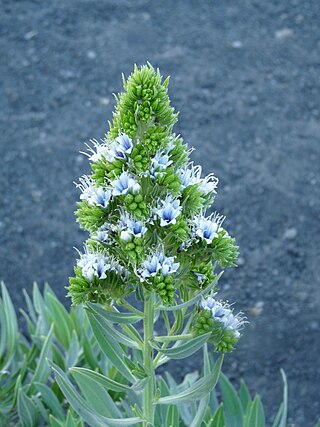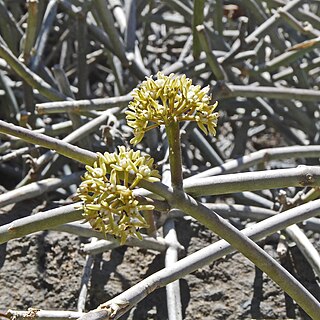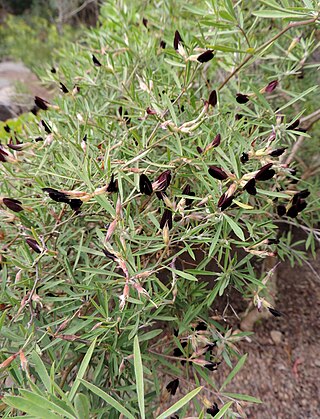
Tarrafal de Monte Trigo is a settlement in the southwestern part of the island of Santo Antão, Cape Verde. In 2010 its population was 841. It is situated on the coast, 27 km west of the island capital Porto Novo. The settlement was mentioned as Terrafal in the 1747 map by Jacques-Nicolas Bellin.

Tarrafal is a city in the northern part of the island of Santiago, Cape Verde. In 2010 its population was 6,656. It is a fishing port situated on the northwestern coast. It constitutes the seat of the Tarrafal Municipality.

Umbilicus schmidtii is a flowering plant in the family Crassulaceae. The species is endemic to Cape Verde. It is listed as endangered by the IUCN.

Artemisia gorgonum is a species of flowering plants of the family Asteraceae, endemic to Cape Verde. Its local name is losna or lasna. The plant plays a role in traditional medicine.

Euphorbia tuckeyana is a species of flowering plants of the family Euphorbiaceae. The species is endemic to Cape Verde. The species is named after James Hingston Tuckey. Its local name is tortolho. The plants are used for tanning hides. As most other succulent members of the genus Euphorbia, its trade is regulated under Appendix II of CITES.

Echium hypertropicum is a species of flowering plants of the family Boraginaceae. The species is endemic to Cape Verde. It is listed as an endangered plant by the IUCN.

Echium stenosiphon is a plant species of the family Boraginaceae. The species is endemic to Cape Verde. Its local name is língua-de-vaca, a name that may also refer to the related species Echium vulcanorum and Echium hypertropicum. The plant is used in traditional medicinal for a cough syrup.
Micromeria forbesii is a species of flowering plants of the genus Micromeria. The species is endemic to Cape Verde. It is listed as endangered by the IUCN. It was first described by George Bentham in 1834. Its local name is erva-cidreira, or cidreirinha. In traditional medicine, it is used as an infusion for the treatment of indigestion, diarrhea, cough and to stimulate labour.

Echium vulcanorum is a species of flowering plants of the family Boraginaceae. The species is endemic to Cape Verde. It is listed as an endangered plant by the IUCN. The species was first described in 1935 by Auguste Chevalier. Its local name is língua-de-vaca, a name that may also refer to the related species Echium hypertropicum and Echium stenosiphon. The oil of its seeds contains γ-linolenic acid, and is used for medicinal and dietary purposes.
Limonium jovibarba is a species of flowering plants of the family Plumbaginaceae. The species is endemic to Cape Verde. It is listed as critically endangered by the IUCN. The species was named by Carl Ernst Otto Kunze in 1891. Its local name is carqueja, a name that may also refer to the related species Limonium brunneri and Limonium braunii.
Limonium brunneri is a species of flowering plants of the family Plumbaginaceae. The species is endemic to Cape Verde. It is listed as critically endangered by the IUCN. The species was named by Carl Ernst Otto Kunze in 1891. Its local name is carqueja, a name that may also refer to the related species Limonium braunii and Limonium jovibarba.
Limonium braunii is a species of flowering plants of the family Plumbaginaceae. The species is endemic to Cape Verde. It is listed as an endangered plant by the IUCN. The species was first described by the German Carl August Bolle as Statice braunii and was placed in the genus Limonium by the French Auguste Chevalier in 1935. Its local name is carqueja, a name that may also refer to the related species Limonium brunneri and Limonium jovibarba.
Limonium lobinii is a species of flowering plants of the family Plumbaginaceae. The species is endemic to Cape Verde. It is listed as an endangered species by the IUCN. The species was first described by Norbert Kilian and Teresa Leyens in 1994. Its local name is carqueja-de-Santiago.

Erysimum caboverdeanum is a species of flowering plants of the family Brassicaceae. The species is endemic to Cape Verde. It is listed as a critically endangered plant by the IUCN. The species was first described by Auguste Chevalier in 1935 as Matthiola caboverdeana; it was placed into the genus Erysimum by Per Øgle Sunding in 1974. Its local name is cravo-brabo. It is used in traditional medicine.
Conyza feae is a species of flowering plant that belongs to the family Asteraceae. The species is endemic to Cape Verde. It is listed as an endangered plant by the IUCN. First described as Nidorella feae, it was placed in the genus Conyza by Hiram Wild in 1969. The specific name feae refers to the Italian naturalist Leonardo Fea. Its local name is losna-brabo or losna-bravo. The plant plays a role in traditional medicine.

Conyza varia is a species of flowering plants of the family Asteraceae. The species is endemic to Cape Verde. It is listed as an endangered plant by the IUCN. First described as Erigeron varius by Philip Barker Webb, it was placed in the genus Conyza by Hiram Wild in 1969. Its local name is marcelinha or tabua, tabuinha. The plant plays a role in traditional medicine: crushed and heated leaves are used to treat external inflammations.

Cynanchum daltonii, synonym Sarcostemma daltonii, is a species of flowering plants of the family Apocynaceae. The species is endemic to Cape Verde. The specific name refers to Joseph Dalton Hooker. The species was named by Joseph Decaisne, as Sarcostemma daltonii, in 1849. Its local name is gestiba. The plant is used in traditional medicine to relieve and treat dental problems.

The Flora of Cape Verde includes the flowers and plants of Cape Verde, mostly native to the islands. There are about 240 species of plants.

Periploca laevigata is a species of flowering plant in the family Apocynaceae, native to the Canary Islands, the Savage Islands and Cape Verde.

Lotus jacobaeus is a species of flowering plant of the family Fabaceae. The species is endemic to Cape Verde. It was described by Carolus Linnaeus in 1753 in the second volume of Species Plantarum.














